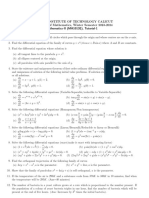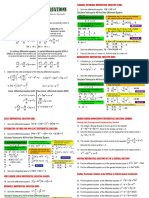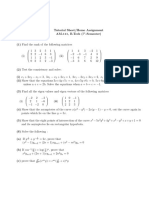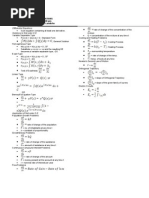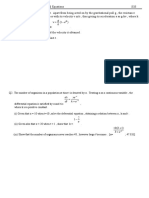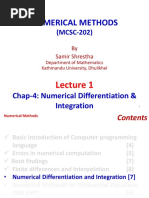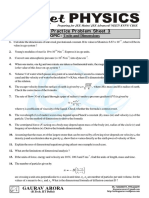0 ratings0% found this document useful (0 votes)
173 viewsMATH207 - Assignment 1
1. Solve various first order differential equations and initial value problems involving exponential, logarithmic, trigonometric, and hyperbolic functions.
2. Develop mathematical models and solve related problems for exponential growth, airplane takeoff speed, sugar inversion rate, Newton's law of cooling, current in an RC circuit, and drug injection into the bloodstream.
3. Find the integrating factor for a differential equation of the form M(x,y)dx + N(x,y)dy = 0 and use it to solve the given equation (x + xy)dx + (y - xy)dy = 0.
Uploaded by
BinoCopyright
© © All Rights Reserved
Available Formats
Download as PDF, TXT or read online on Scribd
0 ratings0% found this document useful (0 votes)
173 viewsMATH207 - Assignment 1
1. Solve various first order differential equations and initial value problems involving exponential, logarithmic, trigonometric, and hyperbolic functions.
2. Develop mathematical models and solve related problems for exponential growth, airplane takeoff speed, sugar inversion rate, Newton's law of cooling, current in an RC circuit, and drug injection into the bloodstream.
3. Find the integrating factor for a differential equation of the form M(x,y)dx + N(x,y)dy = 0 and use it to solve the given equation (x + xy)dx + (y - xy)dy = 0.
Uploaded by
BinoCopyright
© © All Rights Reserved
Available Formats
Download as PDF, TXT or read online on Scribd
You are on page 1/ 1
Subject: Math 207 - Differential Equations and Complex Variables
Homework – 1 (Linear First order ODE)
————————————————————————————————————————–
1. Solve the following first order differential equations, Initial value problems (Show the details of the
work):
(a) 2xydx + x2 dy = 0 (i) y 0 + x2 = x2 e3y
(b) (x2 y − 2xy 2 )dx = (x3 − 3x2 y)dy (j) xy 0 + y = y 2 log x
xdy−ydx
(c) xdx + ydy + x2 +y 2 =0 (k) (xy 3 + y)dx + 2(x2 y 2 + x + y 4 )dy = 0
(d) y 0 + y sin x = e cos x (l) y 0 = 2(y − 1) tanh 2x, y(0) = 0
(e) (2 cos y + 4x2 )dx = x sin ydy (m) xy 0 = y + x2 sec(y/x), y(1) = π
(f) y 0 + xy = xy −1 (n) 3y 2 dx + xdy = 0, y(1) = 1/2
(g) 2x tan ydx + sec2 ydy = 0 (o) ex y 0 = 2(x + 1)y 2 , y(0) = 1/6
y
√
(h) y 0 + 3 = 13 (1 − 2x)y 4 (p) 2yy 0 + y 2 sin x = sin x, y(0) = 2
2. Mathematical Modeling (Develop a mathematical model and solve related problems):
(a) (Exponential Growth): If relatively small populations are left undisturbed, then the time
rate of growth is proportional to the population present. If in a culture of yeast the rate of
growth y 0 (t) is proportional to the amount present y(t) at time t, and if y(t) doubles in 1 day,
how much can be expected after 3 days at the same rate of growth? After 1 week?
(b) (Airplane takeoff ): An airplane taking off from a landing field has a run of 2 kilometers. If
the plane starts with a speed of 10 meters/sec, moves with constant acceleration, and makes
the run in 50 sec, with what speed does it take off? What happens if the acceleration is 1.5
meters/sec2 .
(c) (Sugar Inversion): Experiments show that rate of inversion of cane sugar in dilute solution
is proportional to the concentration y(t) of unaltered sugar. Let the concentration at t = 0
and at t = 4 hours. Find y(t).
(d) (Newton’s Law of Cooling): Experiments show that the time rate of change of the tem-
perature T of a body is proportional to the difference between T and the temperature TA
of the surrounding medium. A thermometer, reading 5◦ C , is brought into a room whose
temperature is 22◦ C. One minute later the thermometer reading is 12◦ C. How long does it
take until the reading is practically 22◦ C, say, 21.9◦ C.
(e) (Current): Find the current I(t) in the RC circuit, assuming that E = 100 volts, C = 0.25
farad, R is variable according to R = (200 − t) ohms when 0 ≤ t ≤ 200 sec, R = 0 when
t > 200.
(f) (Current): If a electromotive force of 160 cos 5t is impressed on a series circuit composed of
a 20 Ω resistor and a 10−1 H inductor, then find the steady state and transient current in the
circuit.
(g) (Drug injection) Find and solve the model for drug injection into the bloodstream if, be-
ginning at t = 0, a constant amount A gm/min is injected and the drug is simultaneously
removed at a rate proportional to the amount of the drug present at time t.
∂M
∂M − ∂N
3. If M (x, y)dx + N (x, y)dy = 0 is any differential equation with ∂y 6= ∂N
∂x and ∂y
M +N
∂x
= h(w) where
R
h(w)dw
w = x − y, then show that the integrating factor is F (x, y) = e . Find the integrating factor
and solve (x + xy)dx + (y − xy)dy = 0.
4. Find orthogonal trajectories for the following:
√
(a) y = x+c (c) y = x + ce−x
x2 y2
(b) (x − c)2 + y 2 = c2 (d) a + a−λ =1
You might also like
- Fujitsu Trouble Shooting Guide: Current ModelsNo ratings yetFujitsu Trouble Shooting Guide: Current Models4 pages
- Practice Problems For MATH/MTHE 232: April 3, 2014No ratings yetPractice Problems For MATH/MTHE 232: April 3, 20145 pages
- Example Sheet For Ordinary Differential EquationsNo ratings yetExample Sheet For Ordinary Differential Equations5 pages
- 23MA1BSMCS UNIT 3 - Ordinary Differential Equations of First OrderNo ratings yet23MA1BSMCS UNIT 3 - Ordinary Differential Equations of First Order5 pages
- Second Order Differential Equations TutorialsNo ratings yetSecond Order Differential Equations Tutorials3 pages
- Tutorial 11 Introduction To Differential Equation V4No ratings yetTutorial 11 Introduction To Differential Equation V44 pages
- First Order Differential Equation (Applications)100% (22)First Order Differential Equation (Applications)18 pages
- Solutions To Practice For Final Exam Math 3400 - Intro To Differential EquationsNo ratings yetSolutions To Practice For Final Exam Math 3400 - Intro To Differential Equations8 pages
- College of Engineering Pune Ordinary Differential Equations and Multivariate Calculus Tutorial-1 (2019-2020)No ratings yetCollege of Engineering Pune Ordinary Differential Equations and Multivariate Calculus Tutorial-1 (2019-2020)3 pages
- Mathematics 1St First Order Linear Differential Equations 2Nd Second Order Linear Differential Equations Laplace Fourier Bessel MathematicsFrom EverandMathematics 1St First Order Linear Differential Equations 2Nd Second Order Linear Differential Equations Laplace Fourier Bessel MathematicsNo ratings yet
- Student Solutions Manual to Accompany Economic Dynamics in Discrete Time, secondeditionFrom EverandStudent Solutions Manual to Accompany Economic Dynamics in Discrete Time, secondedition4.5/5 (2)
- A. Finding Roots of The Equations:: (AlgorithmNo ratings yetA. Finding Roots of The Equations:: (Algorithm2 pages
- Unit 4 Three-Dimensional Geometric Transformation100% (1)Unit 4 Three-Dimensional Geometric Transformation15 pages
- Consider The Above Schema and Answer The Following Questions (1-15) Using Relational Algebraic FormNo ratings yetConsider The Above Schema and Answer The Following Questions (1-15) Using Relational Algebraic Form1 page
- Roots of Equations: Kathmandu UniversityNo ratings yetRoots of Equations: Kathmandu University1 page
- Unit 3 Two-Dimensional Geometric Transformations: TypesNo ratings yetUnit 3 Two-Dimensional Geometric Transformations: Types30 pages
- Synchro-Check Relay: 1MRS 750421-MBG Spau 140 CNo ratings yetSynchro-Check Relay: 1MRS 750421-MBG Spau 140 C8 pages
- Advances in Motor Protection Relay FeaturesNo ratings yetAdvances in Motor Protection Relay Features10 pages
- NEET UG Physics Electromagnetic Waves MCQsNo ratings yetNEET UG Physics Electromagnetic Waves MCQs14 pages
- Computational Study of Different Venturi and Orifice Type Hydrodynamic Cavitating DevicesNo ratings yetComputational Study of Different Venturi and Orifice Type Hydrodynamic Cavitating Devices13 pages
- P6313 Detecting XRays Ionization ChamberNo ratings yetP6313 Detecting XRays Ionization Chamber4 pages
- NEET - Physics # DPP (Motion in 1D) - 05.04.2017100% (1)NEET - Physics # DPP (Motion in 1D) - 05.04.20177 pages
- Multiple integral: r sinθdr d θd ∅ ρ r sinθd ∅ ρ ρ a sinθ dθd ∅ ρ a ρ aNo ratings yetMultiple integral: r sinθdr d θd ∅ ρ r sinθd ∅ ρ ρ a sinθ dθd ∅ ρ a ρ a3 pages
- The Inverse Square Law of Universal Gravitation: - Inversely - Inversely - Square - SquareNo ratings yetThe Inverse Square Law of Universal Gravitation: - Inversely - Inversely - Square - Square1 page
- Numerical Investigation of Thermo Syphon Solar Flat Plate Collector With Back Layer of PCM (Paraffin Wax)No ratings yetNumerical Investigation of Thermo Syphon Solar Flat Plate Collector With Back Layer of PCM (Paraffin Wax)10 pages


